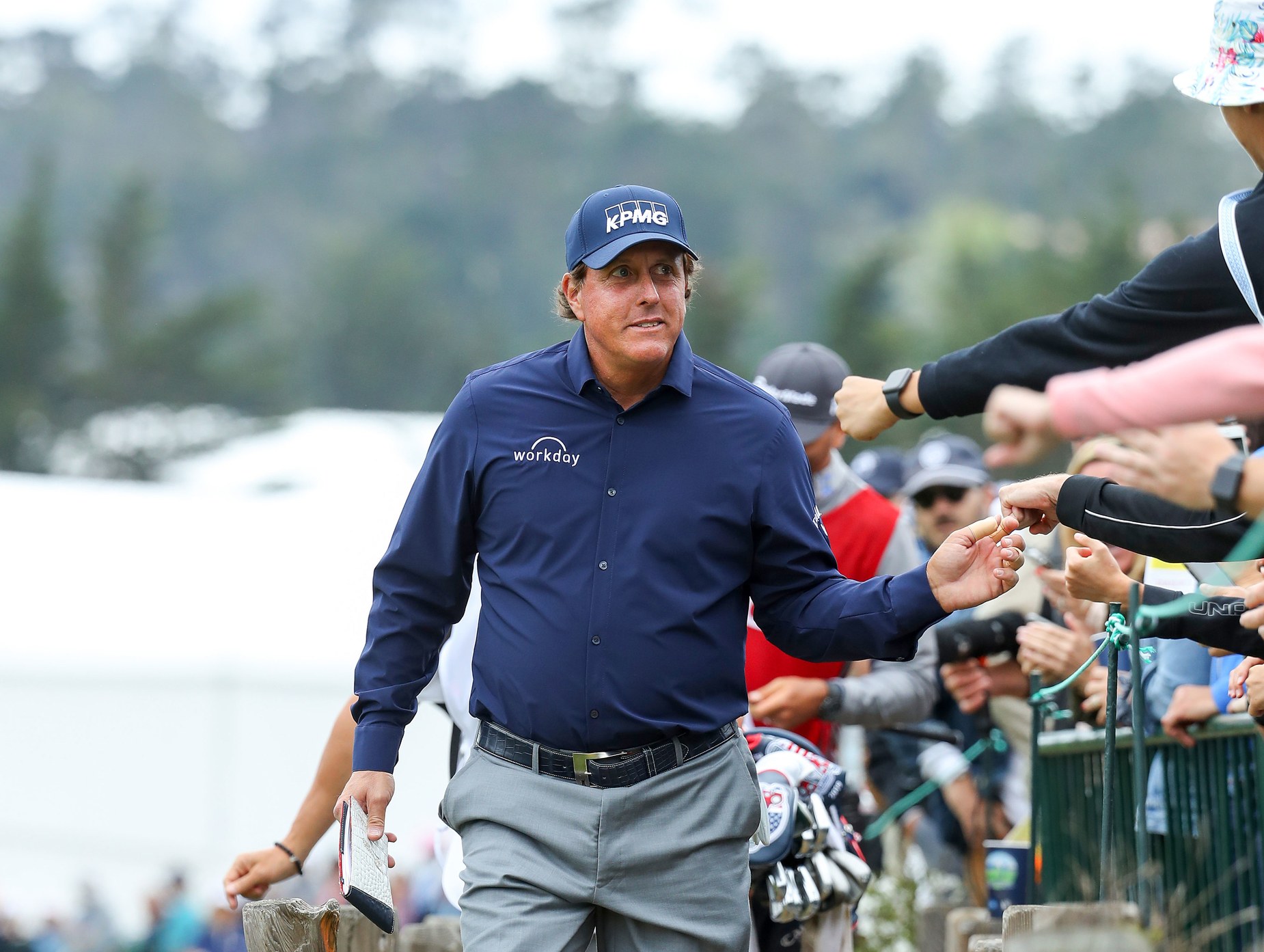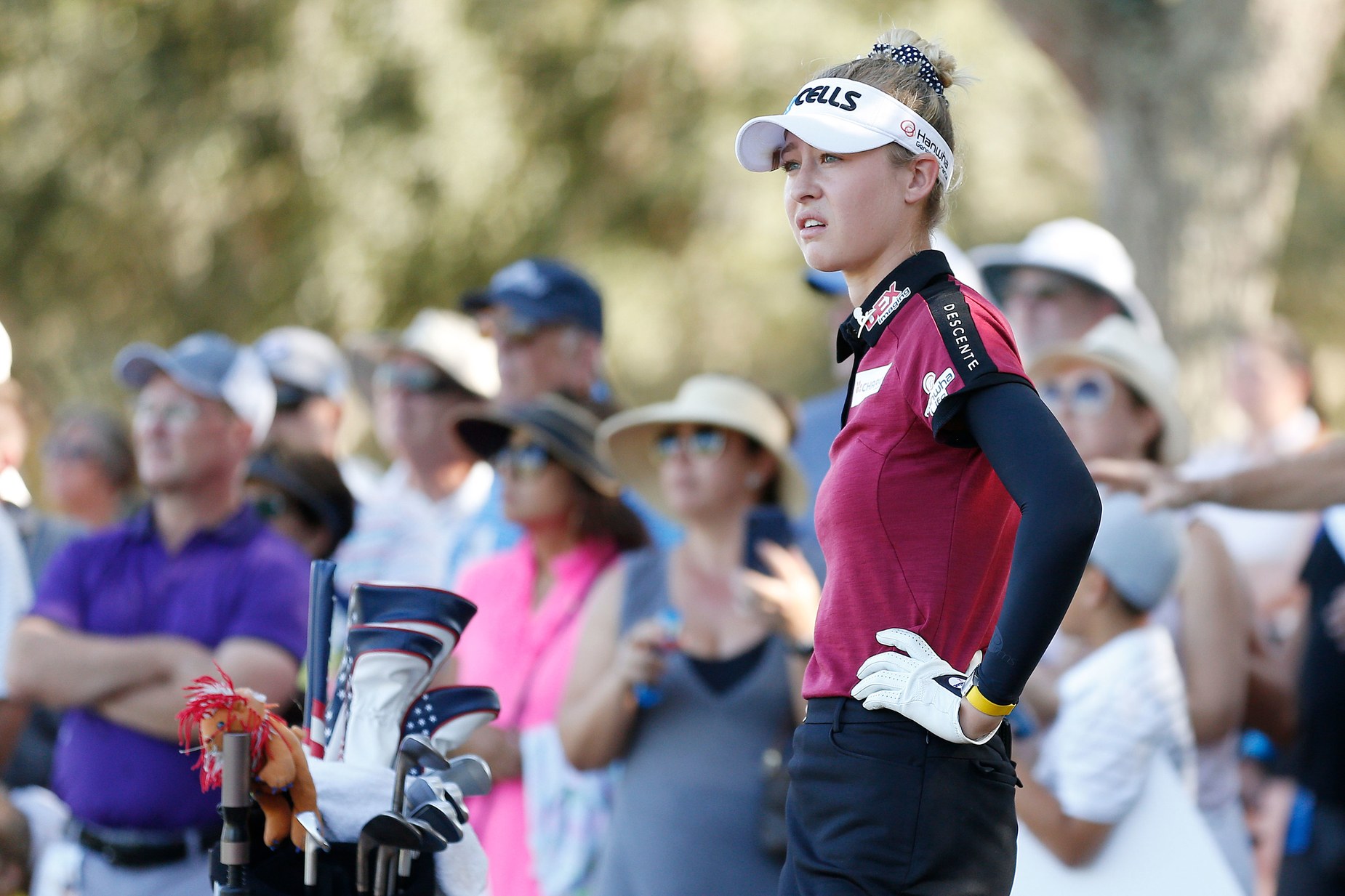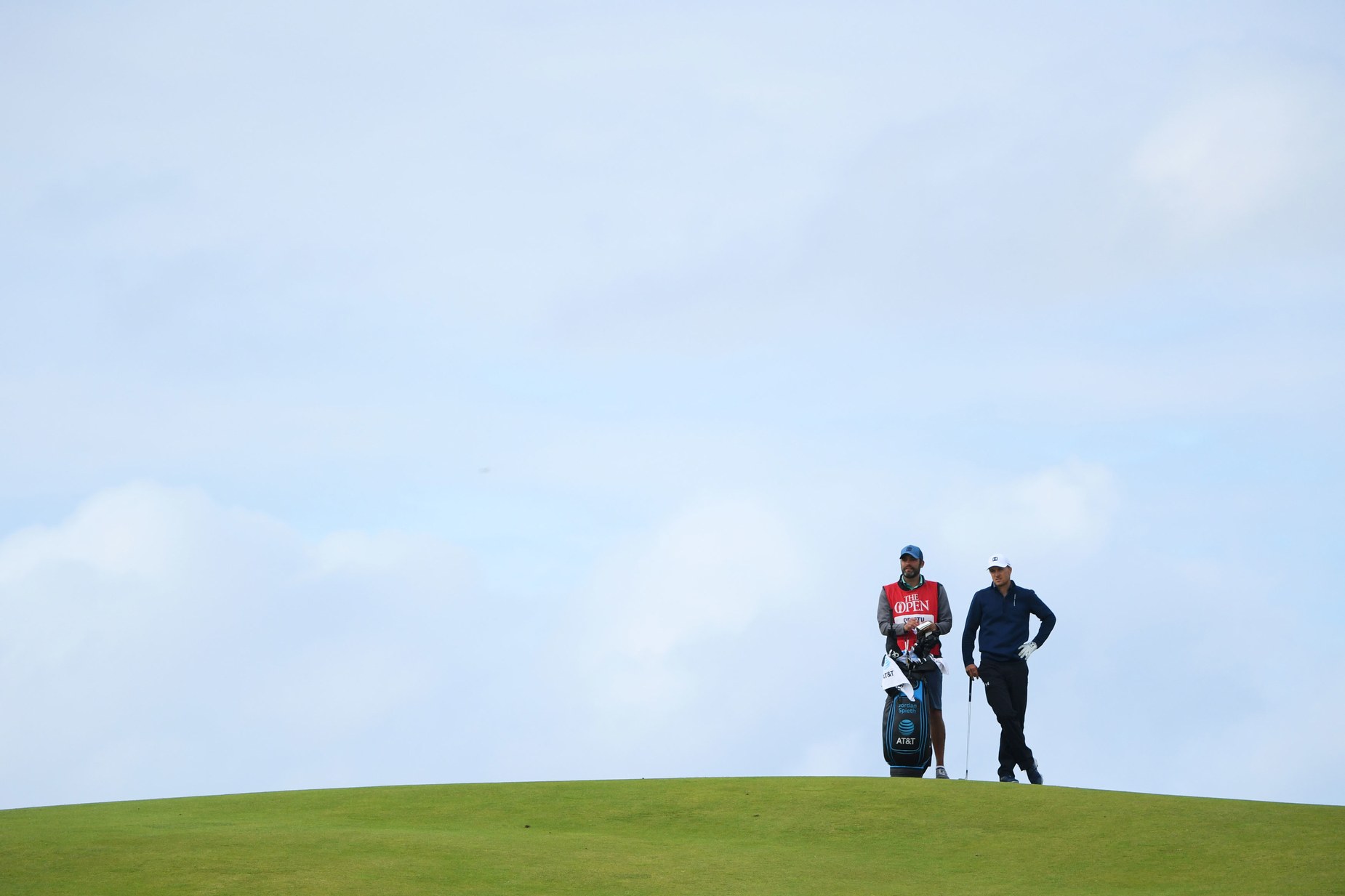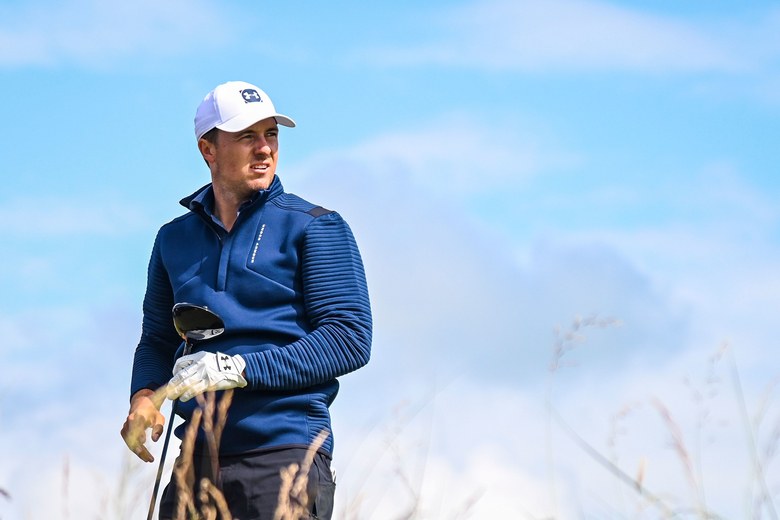Keyur Khamar/PGA Tour
Jordan Spieth watches his tee shot on the 12th hole during the first round of the 2019 Open Championship at Royal Portrush.
By Daniel Rapaport
A cursory scroll through our 2019 Newsmakers package makes one thing clear: Trying to predict who and what will be the year’s biggest stories in golf is often a fool’s errand. Sure, there are the usual suspects, those who will almost assuredly make headlines in 2020—Tiger Woods, Rory McIlroy, Brooks Koepka, etc. But 2019 saw Matt Kuchar, Amy Bockerstette, the Presidents Cup and three players who didn’t turn professional until June crack the top 10 of our year-end list. Try forecasting that!
All this is to say the following list could look very silly by this time next year (or maybe even sometime next month). But that’s not going to stop us from predicting some less obvious people, places and things that, as we see it, will help define golf’s first year in a new decade.
The Tokyo Olympics
In 2016, golf’s return to the Summer Games after more than 100 years away should have been a celebration. Instead, on the men’s side, the lack of big-name players competing in Rio on a newly built, untested course became the primary story. Woods missed it because he was in the throes of his back issues, but the healthy scratches included many of the game’s biggest stars: McIlroy, Jordan Spieth, Jason Day, Dustin Johnson and Adam Scott. Most cited concerns with the Zika virus, but indifference to adding another tournament to their late-summer schedule just two weeks after the year’s final major and two weeks before the FedEx Cup playoff push might have been a silent contributor, too.
Four years later, the Olympics will be held in golf-crazy Japan, where remarkable crowds showed up at the Zozo Championship in October when the PGA Tour held a tournament in the country for the first time. Interest on the ground won’t be an issue—it’s whether the world’s best players will make the trip to Kasumigaseki Country Club outside Tokyo. More seem amendable this time around, and whether they do so will go a long way in determining the long-term impact of winning a gold medal in relation to a golfer’s career accomplishments. Woods has already made clear he wants to participate, as competing in the Olympics is basically the only thing he hasn’t done in golf. His presence has the potential to single-handedly elevate the tournament.
Phil Mickelson
On June 16, Phil Mickelson turns 50, a significant birthday in the golf world. Lefty becomes eligible to play the PGA Tour Champions just two days before the tournament he wants to win most, the U.S. Open, begins at the place where he was closest to winning it: Winged Foot Golf Club in Mamaroneck, N.Y. He’s already older than history’s oldest major winner, and Father Time seemed to make some inroads against Mickelson last year, as he dropped out of the top 50 in the World Ranking for the first time in 26 years.
Still, we can’t put anything past Mickelson, who might be hitting the ball farther than he ever has, and 2020 feels like a bit of a crossroads. There’s the potential he’ll continue to slide down the rankings and transition to a more-limited tournament schedule, or he’ll rediscover some lost accuracy and deliver another late-career flourish. One thing to keep in mind: Lefty will be eligible for the U.S. Senior Open, which will be held at Newport Country Club the week after Winged Foot. How cruelly poetic would it be for Mickelson to win the Senior Open in his first try after an elusive three-decade quest for the U.S. Open?

Warren Little/Getty Images
Mickelson continues to be a fan favourite at the U.S. Open, but he’s running out of chances to win the championship.
Distance Insights Project Report
Sixteen months ago, the USGA and R&A launched the Distance Insights Project, a study to determine the effects of distance on golf writ large. The distance debate, primarily at the professional level, has been going on for years, with critics suggesting several factors, including modern equipment, are rendering classic courses obsolete for high-level tournament play and blurring the lines between truly elite ball-strikers and bombers who wouldn’t be as dominant in other eras. The most common suggestion has been a bifurcation of the rules: one set for the pros, one set for the Joes, with a rollback of the ball among the ideas floated. Officials at the USGA and R&A have gone quiet on where they might stand on the issue, having sent mixed signals in the past and wanting the work of the report to finish without bias. The PGA Tour would have to be on board with any change as well, with it being unlikely they’d be interested in any significant alternatives. (Interestingly, PGA Tour driving distances were down 2.2 yards in the 2018-’19 season.)
No matter its findings, the opening statement of the report, which is expected to be released on Feb. 4, will mark a turning point in the debate. Distance could be deemed a serious problem with an aggressive course of action suggested. Or, more likely, the report will acknowledge increasing distances but prescribe less radical solutions than equipment-based fixes. Put simply: this document could turn the game on its head or be a whole lot of nothing. Smart money is more on the latter, for better or worse.
Nelly Korda
Causal LPGA fans are likely to assume Lexi Thompson is the top-ranked American female golfer, but that title belongs to Nelly Korda, currently third on the Rolex Rankings after starting 2019 ranked 22nd (Thompson is currently 10th). Moreover, there’s reason to think Korda, 21, could continue her rise in 2020; she won two of her final five starts in 2019 and finished tied for third at the CME Group Tour Championship.
The LPGA Tour could always use more star power, and Korda has the potential to be a transcendent player. No American has been ranked No. 1 since Stacy Lewis in 2014. A major championship in 2020 could see the hyper-focused Korda make that leap, or at least become one of the most recognizable faces in golf, male or female.

Michael Reaves/Getty Images
This spring, Korda quietly overtook Lexi Thompson to become the highest-ranked American female golfer.
American Ryder Cup chances
Somewhat lost amid the Presidents Cup drama-vortex is the fact that an extremely strong (on paper) U.S. team nearly lost to a hodgepodge International side that had only two players in the top 20 and an average World Ranking outside the top 50.
The sample size is still too small for a scientist’s liking, but it’s not so small that we can’t say recent U.S. national team performances have fallen short of the sum of their parts. The Americans have lost seven of the past nine Ryder Cups, and 2018’s shellacking at Le Golf National still feels fresh. The U.S. will surely field another loaded team at Whistling Straits, which will be set up to the Americans liking—something approaching 8,000 yards, soft, minimal rough and fast greens. If the Americans can’t win back the cup in September, well … it may be Task Force time again.
Takumi Kanaya
Who’s the best candidate to follow the Matthew Wolff/Viktor Hovland/Collin Morikawa expressway to future pro stardom in 2020? Try a 21-year-old Japanese college student set to graduate in the new year. Takumi Kanaya attends the same school (Tohoku Fukushi University) as Hideki Matsuyama did and, like Matusyama, has become the World No. 1 amateur. Last month, Kanaya won a Japan Tour event and finished tied for third at the Australian Open, earning a spot into next year’s Open Championship. Kanaya’s performances in pro events have him at 216th in the Official World Golf Ranking, ahead of major champions Jimmy Walker, Charl Schwartzel and Jason Dufner.
When Kanaya plays at Royal St. George’s in July it will be his third major appearance after the former Asia-Pacific Amateur champion made the cut in the 2019 Masters, finishing T-58, and missed the cut at the Open at Royal Portrush. There’s no official word on when Kanaya will turn pro, but he’ll surely receive several sponsor’s exemptions whenever he does. He’ll have every chance to prove himself on the biggest stage soon.

Andrew Redington/Getty Images
Kanaya plays a practice round with Hideki Matsuyama ahead of the Open Championship at Portrush.
Grayhawk Golf Club
In late May, the Scottsdale facility will host the men’s and women’s NCAA D-I Golf Championship in back-to-back weeks, the two events sharing the same venue since 2015. This time, however, things are a bit different as Grayhawk’s Raptor course begins a three-year run as site of college golf’s grand finale, a move that has its advocates and detractors.
On one hand, having the championship at the same course annually will help the tournament develop something of an identity, and weather issues that have hampered past championships as the event has rotated to various sites around the country shouldn’t be a problem (save for the Arizona heat). On the other hand, with all due respect to Grayhawk, a relatively unheralded desert course can feel like a bit of a buzzkill for a tournament that has been held at Riviera, the Honors Course, Hazeltine National, Prairie Dunes and Eugene Country Club.
Jordan Spieth’s strokes gained/tee-to-green
As far as Jordan Spieth’s slump goes, you’ve read enough in the way of narratives. We’ll focus on one statistic: strokes gained/tee to green, which measures how a player compares to his peers on every shot that isn’t a putt. Here are Spieth’s rankings in that category for the first six years of his career, starting back in 2013: seventh, 38th, fourth, 25th, second, 23rd.
In 2018-’19, with a -.403 strokes gained/tee to green, Spieth plummeted to 157th. That’s why he struggled so much this summer despite finishing second in strokes gained/putting. Spieth’s swing has been off for more than two years now, and despite his repeated assertions that a fix is right around the corner, the signs of a turnaround have been few and fleeting. Spieth’s putter drew all the headlines, but as he was winning three majors and 11 PGA Tour titles before age 24, it was thanks to being one of world’s very best iron players. He will need to vastly improve his ball-striking from last season if he’s to return to the world elite. And if he doesn’t, you have to wonder whether a more radical change within the Spieth camp might be in the offing.

Matthew Lewis/R&A
Spieth and his caddie, Michael Greller, look on from the 17th fairway during the first round of the 2019 Open at Royal Portrush.









